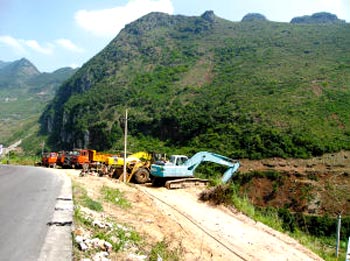| Tools: Save | Print | E-mail | Most Read |
| World Heritage Sites Threatened by Over-exploitation |
| Adjust font size: |
After seven years of deliberations, the Maling River Gorge power station construction project finally started in late September, the China Youth Daily reported on November 6. The Maling River Gorge is located in Xingyi City in southwest China's Guizhou Province. With a total area of 450 square kilometers, the gorge includes 56 main scenic spots. Its imposing and extraordinary landscapes reflect a complete picture of karst topography in the Yunnan-Guizhou Plateau. Because of its unique geomorphology, the area was crowned with the titles of State Natural Heritage in 2006, State Main Scenic Spot in 2004, and State Geological Park in 1994.
The Zhaojiadu power station construction site in the middle section of the Maling River Gorge On September 28, a grand ceremony was held for the start of the power construction project in the gorge. "According to the plan, a 103-meter-long dam will be built. The completion of the power station will give impetus to the economic development of southwestern Guizhou," said the head of the Qianxinan Bouyei-Miao Autonomous Prefecture at the opening ceremony. For local people interviewed by the China Youth Daily, sadness was almost omnipresent. "The dam would destroy the heaven-sent treasured place," they complained. "The start of the project means the verge of collapse of tourist resources in the Maling River Gorge," said Peng Dianji, a member of the prefectural committee of the Chinese People's Political Consultative Conference (CPPCC). Peng and 16 colleagues jointly suggested that the local government remove the power station project from its main construction plans in 2005 and will not approve such a project in the future. "But we haven't got any reply from the government yet," commented Peng. According to Chen Anze, chief engineer and vice director of the China Geological Park Research Center, the Maling River Gorge is a rare global geological site containing almost all karst topography -- ridges, peaks, gorges, caves, underground rivers and waterfalls. "It is a geological site with extremely high research and preservation value," Chen described. The river runs across the mountains forming many rapids and shoals. "Particularly, more than 70 waterfalls formed lots of calciferous accumulations on perpendicular rocks. The unique landscapes represent different geological historical stages. They are rare geological treasures and the best on-the-spot materials in the study of river geomorphology development history," Chen explained. "However, the construction of the dam will submerge the gorge. Riverbeds won't be seen anymore and all geological sites will be destroyed," Chen said. "I can even smell the garbage while drifting about on the water. Once the dikes are built to dam up rivers and streams, those torrents that used to have the self-purification capability will become static lakes and later waste pools," he said, adding that "people should conform to nature instead of always trying to change it." Xie Ninggao, a professor from Peking University's World Heritage Research Center, was restless from anxiety when hearing that two other counties on the upper reaches of the Maling River have applied to build power stations. "The 100,000-kilowatt power station is expected to bring an annual 4 million yuan (US$508,841) to local finance. However, compared with the great profit brought about by the area's tourism development in the future, it isn't worthwhile to build it at the cost of destroying a rare world treasure," he said. Xie analyzed the importance to preserve the natural magical gorge, saying "the gigantic karst geological 'museum' has primitive hydrographic systems and rich biodiversities. With little human disturbance, the micro-climate will continue its value in the future." Xie said their recent investigation conducted in the Shuanglong Scenic Zone in Mount Jinhua, Zhejiang Province, showed that 80 percent of tourists make "experiencing primitive natural landscapes" their first choice. "The appreciation standards of Chinese tourists are rising rapidly," Xie said. "They are in pursuit of high cultural tastes, scientific knowledge and primitive natural landscapes. However, local policy-makers cannot keep up pace with the times. They still plan and over-exploit nature reserves and scenic spots. They want a communication network accessible from all directions while neglecting the fact that preservation of such primitive ecological environments as mountain paths and streams can bring more pleasure to tourists and thus reflect a scenic spot's true value." Xie suggested that local officials look to the future. They should place long-term and comprehensive interests above immediate interests, and they must be fully aware of the fact that no tourist would come if both gorge and torrent ceased to exist, he warned. "People love the unique excitement brought about by drifting on the river, so the dam will make people lose more than the landscape," Xie said, adding that "there is frequent recurrence of similar incidents in many scenic spots. Local governments build houses and start construction projects in these areas with huge investments. Some people may get immediate profits, but they are letting the long-term profits flow away," Xie said. "Meanwhile, we must consider the profits of cultural, ideological and political progress, too. Geological parks and scenic spots usually are the most beautiful places of a country to attract the world. They can better reflect a country's image," Chen Anze added. China currently has 187 scenic spots under state-level protection and more than 500 under provincial-level protection. However, many face over-economic development. "The rare natural resources have been used for more than 5,000 years by our ancestors, and we still use them now. Whether our later generations can use them or not depends on our understanding of the matter," experts said. (China.org.cn by Li Jingrong, November 13, 2006) |
| Tools: Save | Print | E-mail | Most Read |
 |
| Related Stories |
|
Product Directory China Search |
Country Search Hot Buys |
